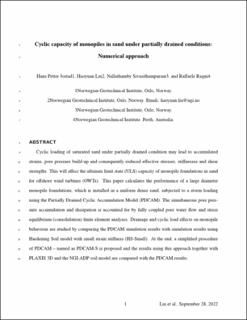| dc.contributor.author | Jostad, Hans Petter | |
| dc.contributor.author | Liu, Haoyuan | |
| dc.contributor.author | Sivasithamparam, Nallathamby | |
| dc.contributor.author | Ragni, Raffaele | |
| dc.date.accessioned | 2022-12-02T07:49:13Z | |
| dc.date.available | 2022-12-02T07:49:13Z | |
| dc.date.created | 2022-11-28T10:37:05Z | |
| dc.date.issued | 2022 | |
| dc.identifier.issn | 1090-0241 | |
| dc.identifier.uri | https://hdl.handle.net/11250/3035519 | |
| dc.description.abstract | Cyclic loading of saturated sand under partially drained conditions may lead to accumulated strains, pore pressure buildup, and consequently reduced effective stress, stiffness, and shear strength. This will affect the ultimate limit state capacity of monopile foundations in sand for offshore wind turbines. This paper calculates the performance of large-diameter monopile foundations, which are installed in uniform dense sand, subjected to storm loading using the partially drained cyclic accumulation model (PDCAM). The simultaneous pore pressure accumulation and dissipation is accounted for by fully coupled pore water flow and stress equilibrium (consolidation) finite element analyses. Drainage and cyclic load effects on monopile behavior are studied by comparing the PDCAM simulation results with simulation results using a hardening soil model with small strain stiffness. At the end, a simplified procedure of PDCAM, named PDCAM-S, is proposed, and the results using this approach together with PLAXIS 3D and the NGI-ADP soil model are compared with the PDCAM results. | en_US |
| dc.description.abstract | Cyclic Capacity of Monopiles in Sand under Partially Drained Conditions: A Numerical Approach | en_US |
| dc.language.iso | eng | en_US |
| dc.title | Cyclic Capacity of Monopiles in Sand under Partially Drained Conditions: A Numerical Approach | en_US |
| dc.title.alternative | Cyclic Capacity of Monopiles in Sand under Partially Drained Conditions: A Numerical Approach | en_US |
| dc.type | Journal article | en_US |
| dc.type | Peer reviewed | en_US |
| dc.description.version | acceptedVersion | en_US |
| dc.source.volume | 149 | en_US |
| dc.source.journal | Journal of Geotechnical and Geoenvironmental Engineering | en_US |
| dc.source.issue | 2 | en_US |
| dc.identifier.doi | 10.1061/JGGEFK.GTENG-10435 | |
| dc.identifier.cristin | 2082219 | |
| dc.relation.project | Norges forskningsråd: 268182 | en_US |
| dc.relation.project | Norges forskningsråd: 296511 | en_US |
| cristin.ispublished | true | |
| cristin.fulltext | postprint | |
| cristin.fulltext | postprint | |
| cristin.qualitycode | 2 | |
